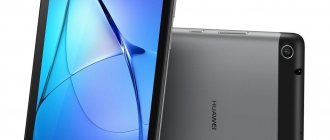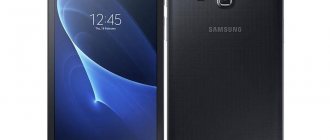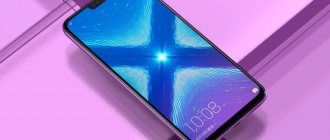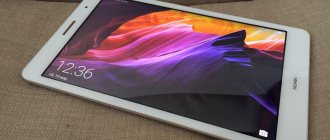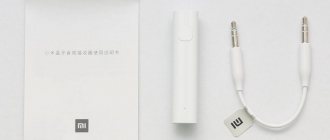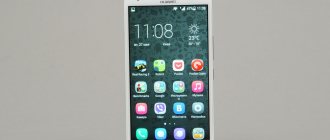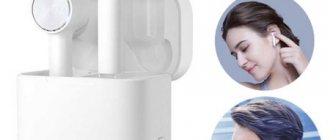Specifications
| Emitter type | Dynamic, 10 mm |
| Connection | Bluetooth 5.0 |
| Frequency range | 20–20,000 Hz |
| Bluetooth protocol | SBC, AAC |
| Battery | Headphones - 37 mAh, case - 410 mAh |
| Working hours | 13 hours |
| Connector | USB Type-C |
| Headphone weight | 5.4 grams |
| Case size | 80 × 35 × 29 mm |
FreeBuds 3 battery review
Most often, I used FreeBuds 3 on the road, which took me 2 hours. All this time, the headphones operated at 50% volume with noise reduction (ANC) turned on. During this period, the battery on both “ears” is discharged by 40% (20% per hour). Thus, experimentally it turned out that the battery operating time is 4.5-5 hours.
If you don't activate ANC, the headphones will last about 6 hours, so there's no particular reason to turn off noise cancellation.
In the case, the headphones are recharged quickly - 40 minutes. The case will be able to charge the headphones to 100% two full times.
And you can charge the case not only via cable, but also using wireless charging - this will take about 1 hour.
Appearance
FreeBuds 3i are in-ear headphones with a number of successful, ergonomic solutions. Streamlined housings and angled sound guides provide a comfortable fit and the proper level of insulation. It is also convenient to remove the headphones from the case by holding them by the “legs”.
Photo: Artyom Bagdasarov / Lifehacker
The gadget is protected according to the IPX4 standard, so it is not afraid of sweat and splashes. The headphone housings are entirely made of plastic, with a choice of black and white options.
FreeBuds 3i has three microphones. One is located on the outside of the case, there are also touch panels for control. Two more - on the inside and at the end of the “leg” - provide voice transmission and active noise reduction.
Photo: Artyom Bagdasarov / Lifehacker
Also on the inside are magnetic contacts for charging and a proximity sensor, thanks to which the music is paused as soon as you take one earphone out of your ear.
The oblong-shaped case is equipped with LED indicators on the outside and inside, and also has a magnetic lid. On the back there is a USB Type-C connector for charging and a pairing button. The assembly is of high quality, but due to its large size, the case is difficult to carry in a jeans pocket.
Photo: Artyom Bagdasarov / Lifehacker
In addition to the case, the kit includes a charging cable and four pairs of silicone tips. It is better to handle the latter with care and not lose them: flattened sound guides do not play well with ear pads from third-party manufacturers.
Review of Huawei FreeBuds 3 wireless headphones
Top manufacturers, racing against Apple in everything related to the production of gadgets, are haunted by the laurels of the most popular Apple AirPods, a series of wireless headphones that have gained massive love from users all over the world. The line was recently replenished with a new model with active noise reduction, and naturally, Huawei’s response was not long in coming. The manufacturer immediately presented an alternative in the form of true wireless headphones with active noise cancellation, but at the same time exactly copying the shape of regular AirPods. That is, the shape of the liners. One in which Apple itself did not even try to achieve noise reduction. Today we’ll tell you what the Chinese achieved as a result of this “symbiosis” by testing the world’s first in-ear headphones with an active noise reduction system, Huawei FreeBuds 3.
Specifications of Huawei FreeBuds 3:
- Processor: Huawei Kirin A1
- drivers Ø 14.2 mm
- supported codecs: SBC, AAC
- connection: Bluetooth 5.1
- battery: in headphones 30 mA*h, in case – 410 mA*h
- charging: USB Type-C (5V 1.2A 6W), wireless Qi (2 W)
- Headphone dimensions: 41.5 x 20.4 x 17.8 mm, weight 4.5 g
- case dimensions: 60.9 x 21.8 mm, weight 48 g
- price: 10,990 rubles
What is in the box?
The headphones are supplied in an unusually large box for wireless headphones with a dust jacket, which is twice as large as, for example, the packaging of the Samsung Galaxy Buds+. The volume of the package is not determined by anything, including the size of the contents. It contains everything the same as the others: a plastic case with headphones placed inside, and a Type-C cable. There is not even a set of removable ear pads, which is understandable: the headphones have a finished earbud shape and cannot change their size due to replaceable tips, like in-ear headphones.
No one reads paper instructions of their own free will; it’s boring, but in this case it turned out to be useful. For some reason, it is completely unclear why, the manufacturer made a mechanical button on the case and hid it in such a way that you would never guess its presence without accidentally reading the manual. In all cases, such a button is usually located in the center and in the most visible place, but here everything is exactly the opposite.
See the button on the side? And she is here.
One more note: the included paper note stating that in order to work with the smartphone you need to download a program called AI Life was also very helpful, because the manufacturer has produced so many mobile applications that it would be a headache trying to find what you need in the store. We downloaded it and tried it, but more about the program later.
Ergonomics
But the main strangeness comes next. Why, one might ask, was it necessary to make such an inconvenient shape for the case?! The manufacturer should know as well as you and I that all conversations about the headphone case among users begin and end with an assessment of its size and the ability to carry it in a small jeans pocket. So: Apple AirPods fit, Samsung Galaxy Buds+ also fit, and do you know why? Due to its elongated shape, well! The Huawei FreeBuds 3 case is absolutely round, this is not due to anything other than the desire of the developers to make it “different”, but because of this the case is about one and a half centimeters wider than the same AirPods.
The case, by the way, unlike AirPods and Samsung Galaxy Buds+, although it also looks nice, in reality it turned out to be flimsy and crunches unpleasantly in the fingers with any touch. There is no feeling of monolithic reliability and high cost, which is the case with the aforementioned streamlined and sturdy cases from Apple and Samsung.
The lid, which is hinged, is also, unfortunately, loose and wobbly; there is no feeling of reliability inherent in premium products, but there is a feeling of an ordinary Chinese craft. And a strange cheap decoration in the form of a metal plate fused into glossy, slippery and extremely easily soiled plastic completes the not entirely rosy picture.
Taking the headphones out of the case is also not as convenient as AirPods, because the lid here does not fold back as wide, and the very shape of the very slippery headphones, although similar, is a little more streamlined, so it’s not always possible to grab it with your hands right away. But this form has no problems with installing back: unlike the shapeless Samsung Galaxy Buds+, here it is immediately clear which earphone to insert into which socket. Magnetic latches hold them inside just as nicely and reliably, there are no problems with that.
The headphones themselves have an in-ear design, that is, they do not have rubber pads, which means they practically do not isolate the ear canals from the penetration of external noise. But they can be installed and removed as quickly as possible, and practically do not cause any inconvenience when worn for a long time. The shape is completely copied from AirPods, but the nose itself is slightly longer, so the sound is delivered into the ear canal a little more directionally.
Huawei FreeBuds 3 headphones are protected from moisture according to the IPX4 standard, that is, from sweat and rain. The devices are available in three colors: black, white and red. All options are shiny, varnished, slippery and easily soiled, and in reality are not at all as matte as the artists themselves portray.
Connection and operation
Huawei FreeBuds 3 can and should be used with a smartphone; any devices running Android, Windows and iOS are supported. When connecting, you need to open the case and hold down the side button for a couple of seconds. When the internal diode starts blinking, you can go and connect in the Bluetooth settings. At the same time, on Huawei’s own smartphones, you just need to open the case next to it, and synchronization will occur, accompanied by “magic” animation right on top of any applications that Apple introduced.
The Huawei FreeBuds 3 headphones themselves do not have any hardware buttons or even touch pads: all control here is implemented based on tapping your finger on the headphone body, to which the built-in accelerometer reacts. Moreover, tapping on different inserts leads to different actions. Thus, double tapping on the left activates noise reduction, and interactions with the right lead to starting playback or moving to the next track. Turning on/off the noise reduction system is accompanied by a voice notification in a pleasant female voice in English, but this can be reconfigured in the AI Life application.
Neither the volume level nor the ANC intensity can be adjusted by any touch to the headphones themselves, only through a smartphone. And, of course, detailed reconfiguration of gestures and voice assistant for yourself is possible only on Android OS, but not iOS, where only the most basic functionality is available. Headphones, like smart watches, remember all these resettings, which can be reset by resetting them again through the smartphone application. Moreover, there are limitations even on Android: the elementary and familiar function of pausing playback when removing the earphone from the ear is possible, for some reason, only on smartphones with the proprietary EMUI shell. They should probably fix it over time.
Also available through the smartphone application are the functions of updating the headphone firmware over the air, searching for a lost headphone, and there is also a detailed FAQ for those who still have questions. Everything is in Russian, everything is clearly written.
Even from accidentally turning on the search function, there is insurance: the headphones begin to produce a pleasant sound, from very quiet and increasing to quite loud. For owners of Huawei FreeBuds 3, the manufacturer has prepared a nice bonus in the form of 14 free songs in its own player, which appear in the smartphone only when the headphones are connected. However, to download them you will also have to log in to your Huawei account.
Sound
As mentioned above, Huawei FreeBuds are the first “earbuds” that tried to make an active noise reduction system, despite the fact that they do not have the ability to tightly isolate the ear canal due to the lack of ear pads. In general, there is no inherent noise isolation, like in-ear headphones. The active noise reduction (ANC) system works here in a unique way. The “anti-noise” created by the headphone speakers themselves is somehow too rough and noticeable.
That is, when the noise reduction is turned on, the headphones begin to emit their own, quite noticeable noise in the user’s ears, and the intensity of this noise can also be increased using the scroll wheel on the smartphone. Then it becomes generally booming, but, unfortunately, this practically does not help: the sound of the TV in the room, as heard, remained clearly distinguishable, and it is the discernibility of sounds that the brain responds most strongly to, and not to the background noise of the subway, streets or airport. In general, the value of the built-in ANC is overrated; unfortunately, it is of practically no use.
The very sound of Huawei FreeBuds 3 can only be praised. It's a little surprising how nice a clean sound they produce with rich mids and well-defined, detailed vocals. With lows and bass here, of course, due to the lack of passive noise insulation, there is worse, but they are not present in any other earbuds. In general, even in comparison with AirPods, the sound seemed very decent, although Apple headphones have more pronounced lows, although they are booming. There is no booming bass here, but the bright and clear sound is clearly more interesting than that of the Korean Samsung Galaxy Buds+.
If expressed using numbers and names, then high sound quality is also achieved using the patented BT-UHD transmission protocol with a data transfer rate of up to 6.5 Mbit/s. The new Kirin A1 chip supports Bluetooth 5.1 transmission. Proprietary dual channel synchronous transmission technology allows you to quickly connect via Bluetooth to devices, and 356 MHz audio processing technology ensures precise synchronization of audio and video tracks. All this together makes Huawei FreeBuds 3 the world's first BT/BLE dual-mode headphones with such capabilities.
Autonomy
As with most wireless headphone models, the case has its own built-in battery. Its capacity is 410 mAh, which should be enough for approximately 4 full charges. The built-in batteries of the headphones themselves have a capacity of 30 mAh. Here lies the most pleasant part of getting to know Huawei FreeBuds 3: they charge very quickly! A head-to-head comparison revealed that Huawei FreeBuds 3 are fully charged in about 40 minutes, but in the first 20 minutes they managed to charge from zero to 80%. Samsung Galaxy Buds+ charge much more slowly: in the same 40 minutes, the Korean headphones only managed to get 40% charge into their batteries.
There is something interesting about displaying the charge level. With Korean Samsung Galaxy Buds+, the remaining charge of the headphones is always visible on the smartphone screen, but the charge of the case, even if you bring it to the smartphone and open it, will not be displayed. But if you put at least one earphone in the case, then the charge immediately appears on the application screen. It is not comfortable. So: with Huawei FreeBuds 3, the application always and in any situation displays all three charge levels along with the case, regardless of where and in what order the headphones are currently inserted. The headphone charge lasts for 4.5 - 5 hours when listening at 70% volume. With such lightning-fast charging, and even with the ability to replenish the case’s battery up to 4 times, autonomy doesn’t seem to be a problem here.
Bottom line
The price of Huawei FreeBuds 3 in official Russian retail is 11 thousand rubles. Quite expensive. It is clear that Huawei itself does not think so, and in principle, the attempt to give the market such “uncompromising” in-ear headphones at a time when all other manufacturers bypass this form factor, throwing all the technologies into in-ear options, is pleasing. Be that as it may, these are the world's first headphones of this form factor with active noise reduction technology. It may not work one hundred percent yet, but a precedent, as they say, has been created. It’s difficult to unconditionally recommend Huawei FreeBuds 3 at this price precisely because of the presence of ANC, but simply for high-quality sound it’s a little expensive. However, for fans of the brand, users of smartphones with EMUI, there is probably nothing better to find in this segment. Moreover, updates “arrive” stably, which means that everything can still improve.
Connection and communication
According to generally accepted practice, it is easiest to synchronize headphones with smartphones from the same manufacturer - in this case, Huawei and Honor. Just open the lid and a pop-up menu for connecting will appear on the screen.
With devices from other brands, you must hold the button on the charging case until the LED indicator flashes white. Further pairings occur when the case is opened.
Photo: Artyom Bagdasarov / Lifehacker
The operating range is impressive: the connection to the smartphone was maintained even if you went to the other end of the apartment. There is also no interference on the street. In addition, the left and right channels are connected in parallel and independently of each other - the problem of out of sync in wireless headphones is a thing of the past.
Working in headset mode did not cause any complaints: the device suppresses background noise and clearly conveys what is said to the interlocutor thanks to additional microphones.
No. 2 – HUAWEI FreeBuds 2 Pro
Price: 9,000 rubles
In essence, FreeBuds 2 Pro are the same Flypods from the Honor lineup, but this does not detract from their merits. The headphones are securely fixed in the included case due to good magnets. Therefore, there will be no situation with them that you put the headphones in the case to charge, and when you opened it, you discovered that one of the accessories was still discharged. Due to the use of high-quality membranes in FreeBuds 2 Pro, the gadget produces a balanced frequency range and deep bass.
In reviews, owners note that the Bluetooth 5.0 connection works – the connection with the smartphone remains stable at a distance of up to 10 meters. If you put the phone in your jacket, the situation does not change at all. One of the disadvantages of the model is the glossy surface of the case, which, like a magnet, attracts fingerprints and various dust.
HUAWEI FreeBuds 2
Control
You can interact with FreeBuds 3i using voice commands or touch panels. By default, a double tap on each earphone is responsible for starting or pausing, as well as accepting or ending calls. A long press activates noise reduction.
You can set up controls for each earphone in the proprietary AI Life Android application. The only problem is that you can’t adjust the volume using touch panels.
Download QR Code
HUAWEI AI Life
Developer: Huawei Internet Service
Price: Free
Sound quality
Huawei FreeBuds Lite are equipped with 7mm speakers with titanium-coated polyurethane membranes. The developers claim that this design provides richer, smoother bass and no distortion at high frequencies. Advanced Audio Coding Low Complexity (AAC-LC) technology ensures accurate sound in any headphone use scenario. This is also facilitated by separate wireless signal transmission for the right and left audio channels.
The declared range of reproduced frequencies is from 20 Hz to 20 kHz. The sound reserve here is quite good. Bass reproduction is decent. At least I was completely satisfied with them. The sound of the headset is fully consistent with its class. When playing tracks, you can feel the stereo effect and vivid sound details. If we compare this model with wired analogues, then we can’t talk about maximum detail in music. She is average or slightly above average. The fact is that even the most modern Bluetooth protocol is capable of transmitting sound only at 256 Kbps. You can't jump higher than this ceiling. But for a wireless option, these headphones are adequate. In general, it’s quite a universal option.
If you put on your “ears” and don’t turn on the music, you can clearly hear everything that happens nearby. However, as soon as you start a track, all background noise disappears. In this case, external noise is not heard.
Sound
Inside the FreeBuds 3i there are 10mm dynamic drivers with a range of 20–20,000 Hz. The acoustic design is closed, which increases noise insulation and audibility of low frequencies. On the other hand, the feeling of plugs in your ears can be tiring, so you shouldn’t insert the devices too deeply.
The headphones sound with a bass bias, which will appeal to fans of electronic music and rap. Low frequencies are booming and clearly stand out from the general background. As the volume increases, their number also increases: at maximum values, it’s as if subwoofers were screwed to your ears.
Photo: Artyom Bagdasarov / Lifehacker
If you don't indulge in high volume, then the bass does not overwhelm other frequencies. The vocals are not relegated to the background, although the female voices are slightly muffled. When noise reduction is turned on, the mid frequencies fall off, which affects the processing of both vocals and main instruments. However, this allows you to listen to music in noisy environments at a safe volume.
There are not many high frequencies, and they are clearly not of the best quality: instead of the polished metallic ringing of cymbals, some kind of indistinct rustling is heard. However, this is a typical situation for wireless headphones and it’s good that gross distortion is not so noticeable.
Connection
To connect Huawei FreeBuds Lite to a smartphone, tablet or PC, you need to open the case and, without taking out the headphones, hold down the function button for 2 seconds. Next, in the Bluetooth settings of your device, find FreeBuds Lite and connect.
If the headphones have already been connected to another smartphone or tablet, you should hold down the function button on the case for 10 seconds. At this time, a factory reset will occur, and the headphones are ready to connect to a new device.
If the case flashes red when opening or closing, it needs charging. In this case, you will not be able to pair.
Autonomy
FreeBuds 3i has 37 mAh batteries inside. According to the manufacturer, this capacity is enough for 3.5 hours of operation. During the test, the headphones lasted 4 hours, playing music at 50% volume, after which they asked to be charged.
Photo: Artyom Bagdasarov / Lifehacker
The case is equipped with a 410 mAh battery and is capable of replenishing the gadget’s energy up to three times. Fully charging the case and headphones takes just over 2 hours.
Review
The materials are high-quality, 4 built-in microphones provide excellent sound quality to the voice of the interlocutor and the owner during negotiations, and noise reduction allows you to communicate even in noisy places.
Huawei's operating time lasts for a whole day if the case is fully charged.
Bluetooth headphones work autonomously for 3.5 hours, which is enough for a jog or workout in the gym. The cost of the device is above average.
Appearance
Externally, the Bluetooth device does not resemble its predecessor Huawei Freebuds 3.
The design is radically different: the previous model is round and compact, while the current one is more reminiscent of Honor Magic Earbuds.
The previous model supports wireless charging, but the new model does not have this feature.
The tube is streamlined, but difficult to transport in a pocket.
The design is simple and concise, but scratches may form on the surface over time. It is worth wiping the coating with a napkin and buying a cover.
The charging hole is located on the case, which is easy to open by lifting the lid. The Huawei Freebuds 3i release date is June 5, 2020.
Results
In Russia, Huawei FreeBuds 3i cost 8,990 rubles. For this money, the headphones offer a comfortable fit, convenient controls, noise reduction and good sound. The only thing I would like to complain about is the overly voluminous case. Otherwise, we have a good product, which only benefits from its similarity to AirPods Pro.
Buy
The author thanks Huawei for providing the device for testing. The company had no opportunity to influence the test result.
Noise reduction
Huawei FreeBuds 3i also has good noise reduction. More recently, it has a third mode - “Transparency”. Switching between them is simple: just hold your finger on the touch area of any of the headphones for two seconds. During the mode change, a female voice will notify you of what is currently activated: Off, Noise Cancellation, and Awareness.
The headphones themselves absorb noise very well due to their form factor. I came to the office to pick them up and sat down to write the text while listening to music at the same time. As a result, they wrote to me on Telegram, because they tried to shout to me, but it still didn’t work out. And then I found out that it was purely passive noise insulation!
Then I turned on ANC. The noise has become significantly less. For example, I practically don’t hear the clicking sound of the “scissor” keyboard of my MacBook, listening to music even at 30-50% of the volume. Most of the lower register of the vacuum cleaner noise is cut off, but the highs remain slightly muffled. And then you turn up the volume to 70% and the scream of the vacuum cleaner is not audible at all.
I haven’t had a chance to check the quality of noise reduction in the subway, and it’s not yet very clear when it will be possible.
Huawei claims a 32 dB reduction in noise levels. It is quite difficult to assess the veracity of these statements by ear, since there is also excellent passive sound insulation.


